My Mother’s Peasant Bread: The Best Easiest Bread You Will Ever Make
This post may contain affiliate links. Please read my disclosure policy.
This is the no-knead bread recipe my mother has been baking for 45 years. Start to finish, it can be ready in three hours. It bakes in well-buttered Pyrex bowls — no need to preheat a baking vessel for this recipe — and it emerges golden and crisp with a soft, tender crumb. 🍞🍞🍞🍞🍞
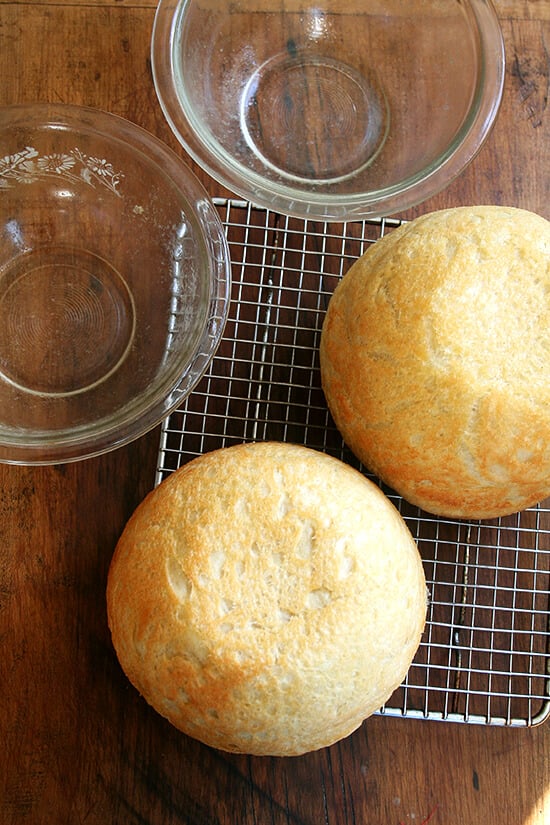
When I tell you that, if forced, I had to pick one and only one recipe to share with you that this — my mother’s peasant bread — would be it, I am serious. I would almost in fact be OK ending the blog after this very post, retiring altogether from the wonderful world of food blogging, resting assured that you all had this knowledge at hand. This bread might just change your life.
The reason I say this is simple. I whole-heartedly believe that if you know how to make bread you can throw one hell of a dinner party. And the reason for this is because people go insane over homemade bread. Not once have I served this bread to company without being asked, “Did you really make this?” And questioned: “You mean with a bread machine?” But always praised: “Is there anything more special than homemade bread?”
And upon tasting homemade bread, people act as if you’re some sort of culinary magician. I would even go so far as to say that with homemade bread on the table along with a few nice cheeses and a really good salad, the main course almost becomes superfluous. If you nail it, fantastic. If you don’t, you have more than enough treats to keep people happy all night long.
The Magic of the Peasant Bread
So what, you probably are wondering, makes this bread so special when there are so many wonderful bread recipes out there? Again, the answer is simple. For one, it’s a no-knead bread. I know, I know. There are two wildly popular no-knead bread recipes out there.
But unlike the others, this is a no-knead bread that can be started at 4:00pm and turned out onto the dinner table at 7:00pm. It bakes in well-buttered Pyrex bowls — there is no pre-heating of the baking vessels in this recipe — and it emerges golden and crisp without any steam pans or water spritzes. This is not artisan bread, nor is it trying to be. It is peasant bread, spongy and moist with a most-delectable buttery crust.
Genuinely, I would be proud to serve this bread at a dinner party attended by Jim Lahey, Mark Bittman, Peter Reinhart, Chad Robertson, Jeff Hertzberg and Zoe Francois. It is a bread I hope you will all give a go, too, and then proudly serve at your next dinner party to guests who might ask where you’ve stashed away your bread machine. And when this happens, I hope you will all just smile and say, “Don’t be silly. This is just a simple peasant bread. Easy as pie. I’ll show you how to make it some day.”
Peasant Bread Variations
Once you master the peasant bread, you can make any bread your heart desires — this simple no-knead bread recipe is the foundation of many of the other bread recipes on this site, namely this hugely popular overnight refrigerator focaccia and this simple homemade pizza dough. It’s even the inspiration behind this sourdough focaccia and this sourdough sandwich bread and this simple pita bread recipe.
The below post is organized as follows:
- How to Make Peasant Bread, Step by Step
- The Best Way to Store Bread
- Peasant Bread Dinner Rolls
- Peasant Bread Sandwich Bread
- How to Add Seeds and Nuts to Bread Dough
- How to Make Gluten-Free Peasant Bread
- How to Coat the Loaves in Seeds
- How to use Whole Wheat Flour
- How to Bake the Peasant Bread in a Dutch Oven
Many more variations on the peasant bread can be found in my cookbook, Bread Toast Crumbs:
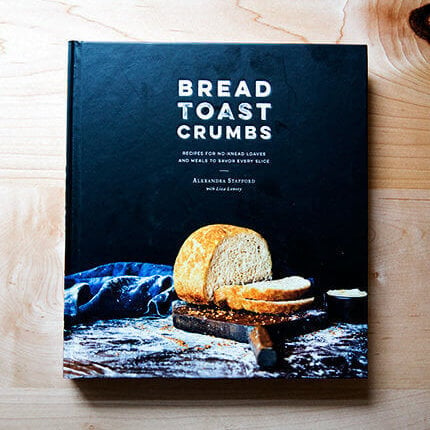
Bread Toast Crumbs
Love the peasant bread? There’s now a book filled with 40 simple bread recipes plus 70 recipes to use up every crumb of every loaf you bake.
How to Make Peasant Bread, Step by Step
First: You need yeast.
This is the yeast I buy exclusively: SAF Instant Yeast. Instant yeast can be whisked into the flour directly without any blooming or proofing. If you want to stick to active-dry yeast, there are instructions in the recipe notes on how to do so. Red Star yeast is great.

Whisk together flour, salt, sugar, and instant yeast. Add lukewarm water.
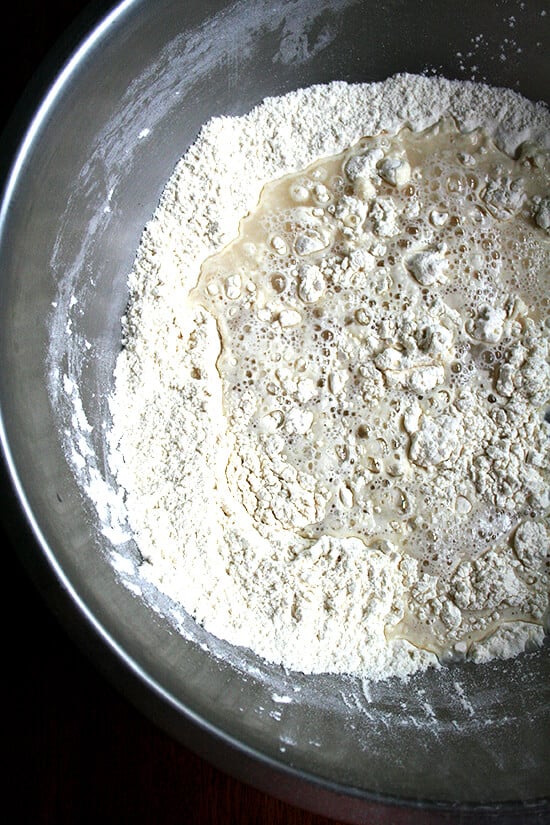
Mix until you have a sticky dough ball. Let it rise for 1.5 to 2 hours…
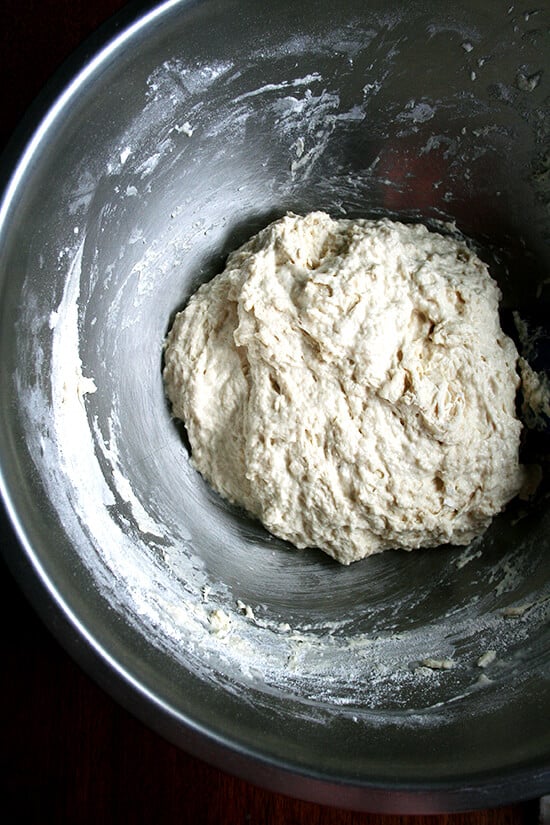
… or until it looks like this:

Punch down the dough using two forks.
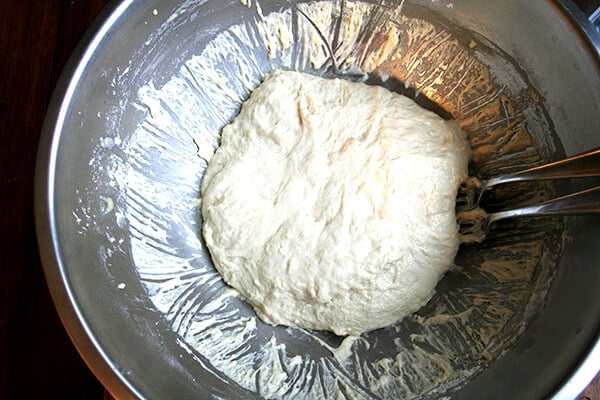
Then split the dough down the middle again using the two forks.

Because this is a very wet dough, it must be baked in an oven-proof bowl. I am partial to the Pyrex 1L 322 size, but any similarly sized oven-proof bowl will work.

Butter the bowls well; then transfer half of the dough to each prepared bow.

Let the dough rise again until it crowns the rim of the bowl, about 30 minutes.
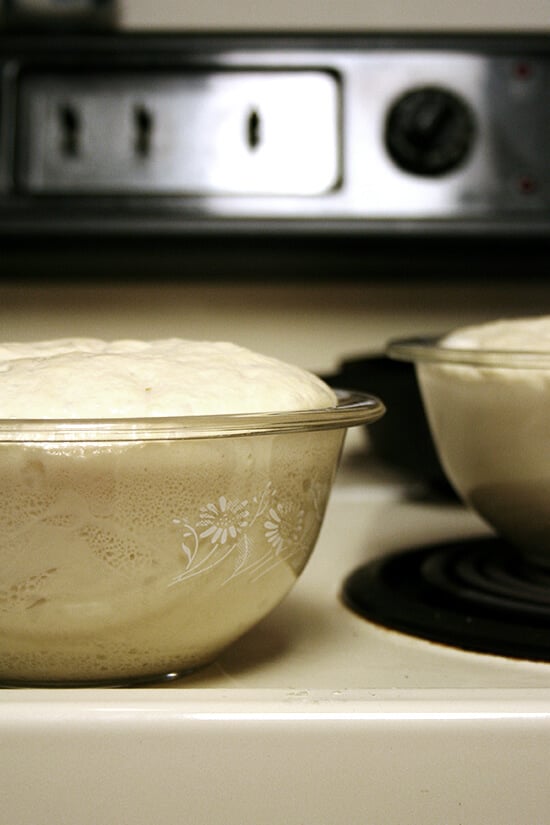
Transfer the bowls to the oven to bake:


This bread is irresistible when it’s freshly baked, but it also makes wonderful toast on subsequent mornings as well as the best grilled cheese. It’s also my favorite bread to use for these egg salad sandwiches and for this no-tuna “tuna” salad.

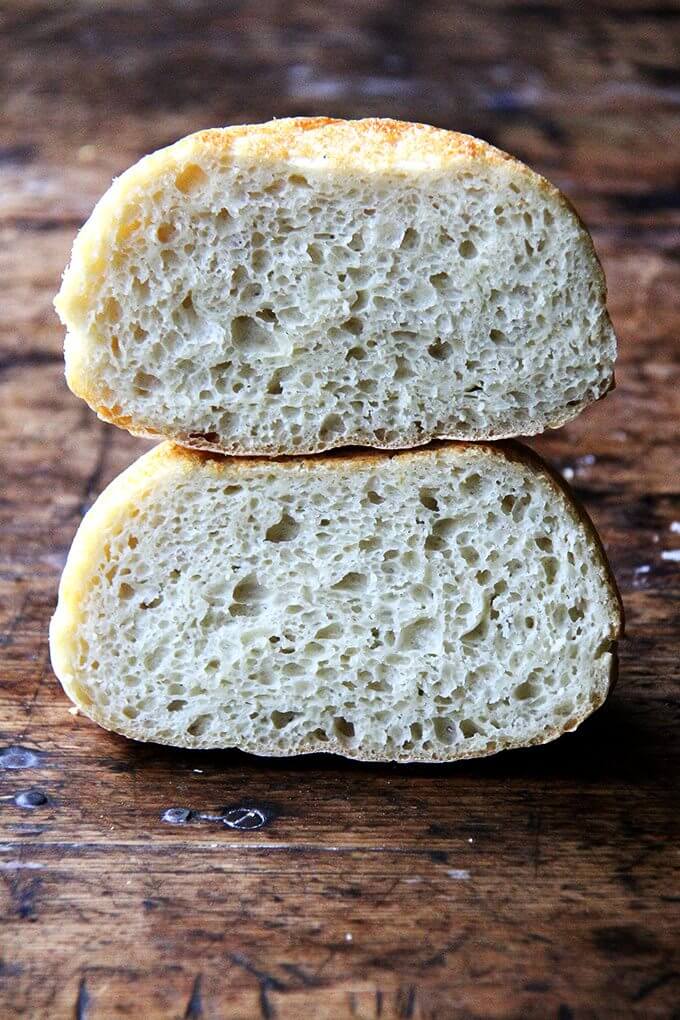
The Best Way to Store Bread
If you want to store the bread at room temperature for 3 to 4 days, I think the best method is in a ziplock bag. I’ve tried other eco-friendly options, but nothing seems to keep bread freshest — the crumb the softest — better than a ziplock bag. You can re-use the bags again and again.
If you intend to keep the bread for longer, I would freeze it. I often slice bread as soon as it cools completely, transfer the slices to a ziplock bag, then freeze. This way, I know the bread was frozen at its freshest.
A ziplock bag will not prevent the crust of bread from turning soft, which is why I suggest always reheating day-old bread. I use a toaster at breakfast for slices of bread, and I reheat half or quarter loaves in the oven at 350ºF for 15 to 20 minutes when serving for dinner.
Bread revives so beautifully in the oven or toaster.

No-Knead Dinner Rolls
To use the peasant bread dough to make rolls, simply divide the dough into smaller portions and place in a buttered muffin tin as in these No-Knead Thyme Dinner Rolls (pictured above). This recipe for no-knead buttermilk pull-apart rolls is also based on the peasant bread as are these brioche pull-apart rolls.
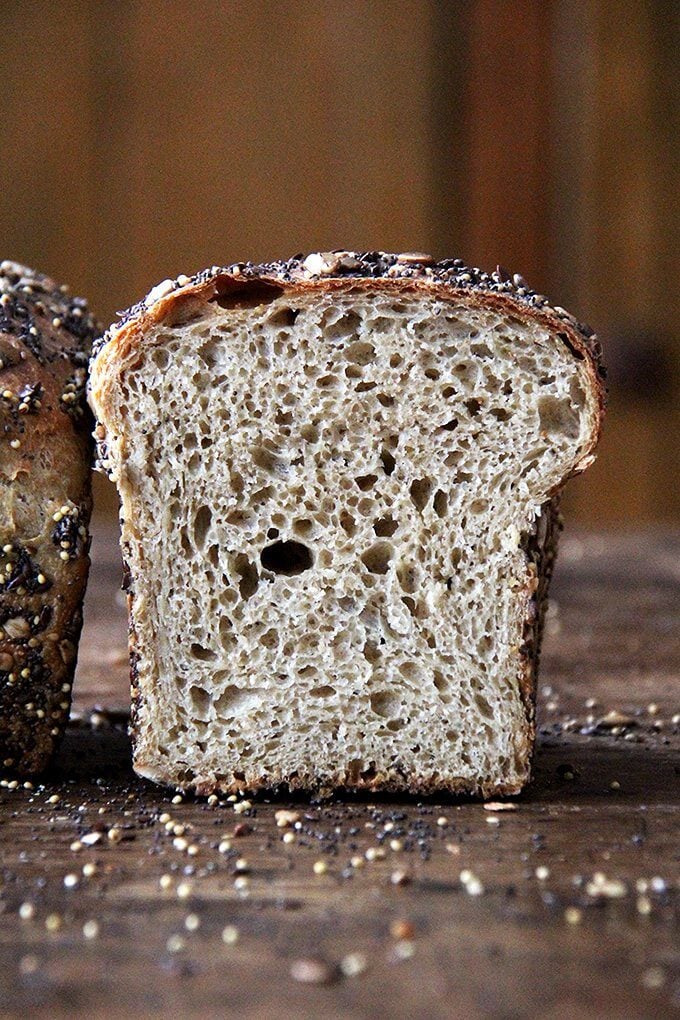
No-Knead Sandwich Bread
To make sandwich bread, multiply the recipe below by 1.5 and bake the bread in two buttered 8.5×4.5-inch loaf pans.
Made with half all-purpose flour and half King Arthur Sprouted Wheat Flour, these seed-coated sandwich loaves (pictured above) have a soft and light crumb. I really like KAF’s sprouted wheat flour, which is made from white whole wheat berries that, when sprouted, yield a creamy, sweet, milder-tasting flour. You can use 100% all-purpose or bread flour for an even lighter loaf or your favorite whole wheat flour in place of the sprouted wheat flour.
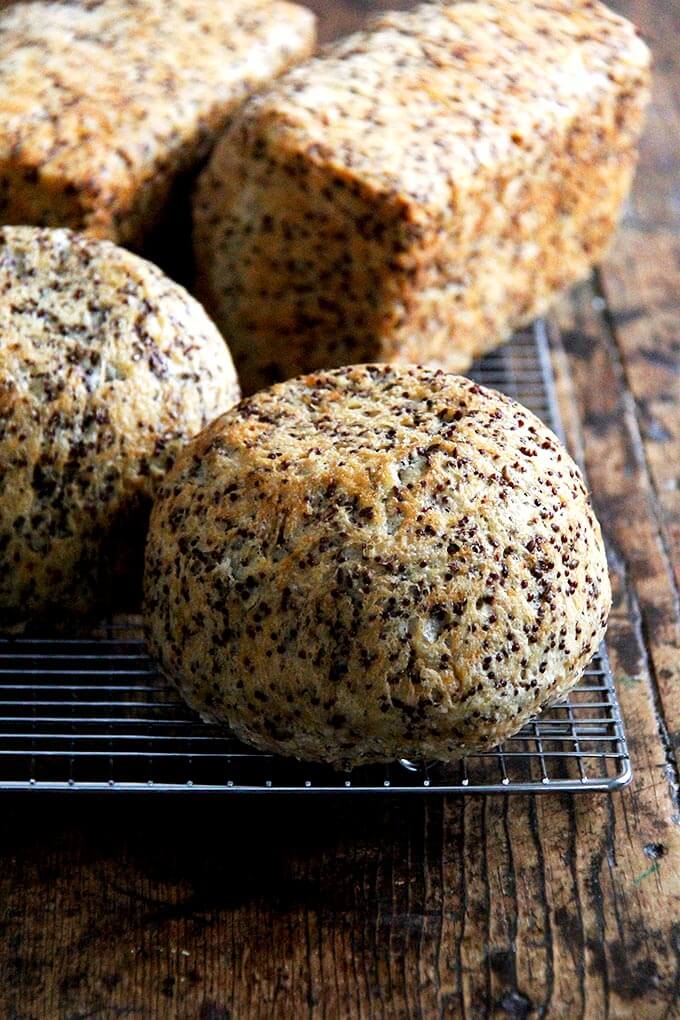
How to Add Nuts and Seeds to Bread Dough
To add seeds and nuts (or dried fruit and cheese), simply stir them into the dry ingredients. This recipe for Quinoa-and-Flax Toasting Bread will offer guidance on how much to add.

How to Make a Gluten-Free Peasant Bread
Making gluten-free peasant bread (pictured above) unfortunately isn’t as simple as swapping in gluten-free flour for the wheat flour. But the process and recipe is still super simple — in fact, because there’s only one rise, many people find the gluten-free peasant bread to be even simpler than the original. Find the recipe here: Gluten-Free Peasant Bread

How to Coat the Loaves in Seeds
To coat the peasant bread in seeds, as pictured above, simply coat the bowls with everything bagel seasoning or with dukkah or sesame seeds or whatever seed mix you wish. The seed-coated loaves look so beautiful, and it’s amazing how much the flavor of the coating permeates the loaves. Find the recipe here: Everything Bagel Seasoning Peasant Bread

How to Use Whole Wheat Flour
To use whole wheat flour in the peasant bread, simply replace as much as 50% of the all-purpose flour with your favorite whole wheat flour: I like KAF’s sprouted wheat flour, and I’ve been loving the Cairnsprings Mill Trailblazer stone-milled flour. With the Trailblazer, I can use up to 75% of it in the peasant bread, and it yields a beautiful, chewy texture as well as a lovely flavor and aroma.
When using whole wheat flour, you may have to use more or less water — there is no rule as to how much more or less, and it will take some trial and error to get right because all flours absorb water differently. When I use KAF sprouted wheat flour, for example, I don’t change the water amount at all. When I use the Trailblazer flour, on the other hand, I reduce the water by at least 50 grams.
If you’d like to learn more about whole wheat flour and stone-milled flours, read this: Easy Sourdough Bread (Whole Wheat-ish)
How to Bake the Peasant Bread in a Dutch Oven
If you’re looking for more of a crackling crusted boule (characteristic of a loaf of sourdough bread) as opposed to the buttery crispness of the peasant bread, you can bake the peasant bread dough in a preheated Dutch oven.
There are detailed instructions below the recipe in the notes section, but one thing to keep in mind before you begin is dough hydration. The peasant bread is a very high hydration dough, meaning there is a lot of water relative to flour. Because baking the peasant bread in a Dutch oven will require some handling of the dough — to shape it into a round and to create some tension — you may want to reduce the water from the start. Consider holding back 20-30 grams of water to make the process more manageable for you.
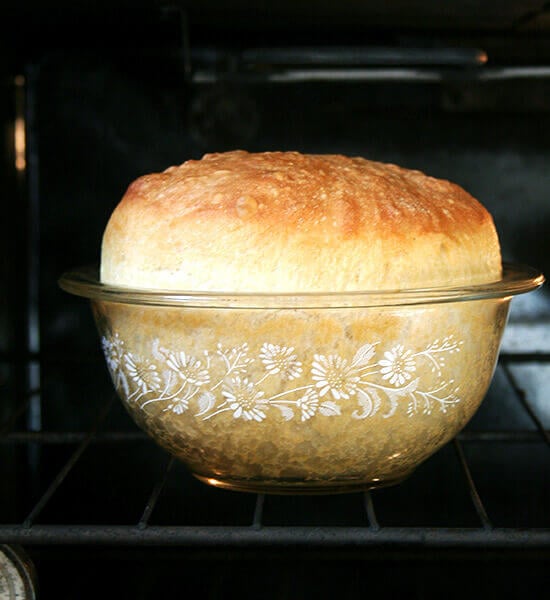
My Mother’s Peasant Bread: The Best Easiest Bread You Will Ever Make
- Total Time: 2 hours 27 minutes
- Yield: 2 loaves
Description
Notes:
The bread:
This is a sticky, no-knead dough, so, some sort of baking vessel, such as pyrex bowls (you need two 1-qt bowls) or ramekins for mini loaves is required to bake this bread. See notes below the recipe for sources. You can use a bowl that is about 2 qt or 2 L in size to bake off the whole batch of dough (versus splitting the dough in half) but do not use this size for baking half of the dough — it is too big.
Peasant Bread Fans! There is now a book: Bread Toast Crumbs, a loaf-to-crumb bread baking book, filled with tips and tricks and answers to the many questions that have been asked over the years. In the book you will find 40 variations of the master peasant bread recipe + 70 recipes for using up the many loaves you will bake. Learn more about the book here or buy it here.
Ingredients
- 4 cups (512 g) unbleached all-purpose or bread flour
- 2 teaspoons (10 g) kosher salt
- 2 cups (454 g) lukewarm water (made by mixing 1.5 cups cold water with 0.5 cup boiling water)
- 2 teaspoons (8 g) sugar
- 2 teaspoons (8 g) instant yeast, I love SAF Instant Yeast, see notes below
- room temperature butter, about 2 tablespoons
Instructions
- Mixing the dough: In a large mixing bowl, whisk together the flour, salt, sugar, and instant yeast (I love SAF Instant Yeast). Add the water. Mix until the flour is absorbed. (If you are using active dry yeast, see notes below.)
- Let it rise. Cover bowl with a tea towel or plastic wrap and set aside in a warm spot to rise for at least an hour. (In the winter or if you are letting the bread rise in a cool place, it might take as long as two hours to rise.) This is how to create a slightly warm spot for your bread to rise in: Turn the oven on at any temperature (350ºF or so) for one minute, then turn it off. Note: Do not allow the oven to get up to 300ºF, for example, and then heat at that setting for 1 minute — this will be too hot. Just let the oven preheat for a total of 1 minute — it likely won’t get above 100ºF. The goal is to just create a slightly warm environment for the bread.
- Preheat the oven to 425ºF. Grease two 1-qt or 1.5-qt oven-safe bowls (see notes below) with about a tablespoon of butter each. Using two forks, punch down your dough, scraping it from the sides of the bowl, which it will be clinging to. As you scrape it down try to pull the dough toward the center (see video below for guidance). You want to loosen the dough entirely from the sides of the bowl, and you want to make sure you’ve punched it down. Then, take your two forks and divide the dough into two equal portions — eye the center of the mass of dough, and starting from the center and working out, pull the dough apart with the two forks. Then scoop up each half and place into your prepared bowls. This part can be a little messy — the dough is very wet and will slip all over the place. Using small forks or forks with short tines makes this easier — my small salad forks work best; my dinner forks make it harder. It’s best to scoop it up fast and plop it in the bowl in one fell swoop. Some people like to use flexible, plastic dough scrapers for this step.
- Let the dough rise again for about 20 to 30 minutes on the countertop near the oven (or near a warm spot) or until it has risen to just below or above (depending on what size bowl you are using) the top of the bowls. (Note: Do not do the warm-oven trick for the second rise, and do not cover your bowls for the second rise. Simply set your bowls on top of your oven, so that they are in a warm spot. Twenty minutes in this spot usually is enough for my loaves.)
- Bake it. Bake for 15 minutes. Reduce the heat to 375º and bake for 15 to 17 minutes longer. Remove from the oven and turn the loaves onto cooling racks. If you’ve greased the bowls well, the loaves should fall right out onto the cooling racks. If the loaves look a little pale and soft when you’ve turned them out onto your cooling racks, place the loaves into the oven (outside of their bowls) and let them bake for about 5 minutes longer. Remove from oven and let cool for 10 minutes before cutting.
Notes
- The bowls: The cheapest, most widely available 1-qt bowl is the Pyrex 322. Update: These bowls are becoming harder to find and more expensive. As a result, I’m suggesting this cheaper option: the Pyrex 3-piece set. You can split the dough in half as always (see recipe) and bake half in the 1-quart bowl and half in the 1.5 quart bowl. The loaves will not be the same shape, but they will be delicious nonetheless.
- Yeast: I buy SAF Instant Yeast in bulk from Amazon I store it in my fridge or freezer, and it lasts forever. If you are using the packets of yeast (the kind that come in the 3-fold packets), just go ahead and use a whole packet — It’s 2.25 teaspoons. I have made the bread with active dry, rapid rise, and instant yeast, and all varieties work. The beauty of instant yeast is that there is no need to “proof” it — you can add the yeast directly to the flour. I never use active-dry yeast anymore.
- If you have active-dry yeast on hand and want to use it, here’s how: In a small mixing bowl, dissolve the sugar into the water. Sprinkle the yeast over top. There is no need to stir it up. Let it stand for about 10 to 15 minutes or until the mixture is foamy and/or bubbling just a bit — this step will ensure that the yeast is active. Meanwhile, in a large bowl, whisk together the flour and salt. When the yeast-water-sugar mixture is foamy, stir it up, and add it to the flour bowl. Mix until the flour is absorbed.
- Troubleshooting: You can find step-by-step video instruction here.
- Several commenters have had trouble with the second rise, and this seems to be caused by the shape of the bowl they are letting the dough rise in the second time around. Two hours for the second rise is too long. If you don’t have a 1-qt bowl, bake 3/4 of the dough in a loaf pan and bake the rest off in muffin tins or a popover pan. The second rise should take no more than 30 minutes.
- Also, you can use as many as 3 cups of whole wheat flour, but the texture changes considerably. I suggest trying with all all-purpose or bread flour to start and once you get the hang of it, start trying various combinations of whole wheat flour and/or other flours.
- The single most important step you can take to make this bread truly foolproof is to invest in a digital scale. This one costs under $10. If you are not measuring by weight, do this: scoop flour into the measuring cup using a separate spoon or measuring cup; level off with a knife. The flour should be below the rim of the measuring cup.
- Here’s a printable version of this recipes that’s less wordy: Peasant Bread Recipe, Simplified
- How to Bake the Peasant Bread in a Dutch Oven: Preheat a Dutch Oven for 45 minutes at 450ºF. Dust a clean work surface with flour. After the first rise, turn the dough out onto the floured surface and shape it into a ball: I like to fold it envelope style from top to bottom, then side to side; then I flip it over and use the pinkie edges of my hands to pinch the dough underneath and create some tension. Transfer the dough to a sheet of parchment paper. Let rest for 20 minutes. If you feel your dough is spreading too much you can lift up the sheet of parchment paper, dough and all, and place it in a bowl of a similar size. After the 20 minutes, transfer the dough, parchment paper and all to the Dutch oven. Carefully cover it. Bake 30 minutes. Uncover. Bake 15 minutes more.
- To bake the peasant bread in a loaf pan: If you are using an 8.5×4.5-inch loaf pan or a 9×5-inch loaf pan, you can bake 3/4 of the dough in it; bake off the rest of the dough in ramekins or other small vessels … the mini loaves are so cute. You can also make 1.5x the recipe, and bake the bread in 2 loaf pans. If you have a large loaf pan, such as a 10×6-inch loaf pan, you can bake off the entire batch of dough in it. For loaf pans, bake at 375ºF for 45 minutes.
- How to Bake at Hight Altitude:
- First try the original recipe as written (preferably with a scale). You may not need to make any adjustments. One commenter, who lives at 9200 ft finds the original recipe to work just fine as is.
- If the original recipe doesn’t work, try adding a little bit more water because it rises fast and it is so dry: about a quarter cup for every 512 g of flour.
- Try decreasing the yeast to 1.5 teaspoons.
- If your dough is especially gooey, try decreasing the water by 1/4 cup. But, if you aren’t using a scale, my first suggestion would be to buy a scale and weigh the flour, and make the bread once as directed with the 2 cups water and 512 grams flour, etc.
- Punch the dough down twice before transferring it to the buttered Pyrex bowls. In other words, let it rise for 1-1.5 hours, punch it down, let it rise again for about an hour, punch it down, then transfer it to the buttered bowls.
- Variations:
- #1. Cornmeal. Substitute 1 cup of the flour with 1 cup of cornmeal. Proceed with the recipe as directed.
- #2. Faux focaccia. Instead of spreading butter in two Pyrex bowls in preparation for baking, butter one 9×9-inch glass baking dish and one Pyrex bowl or just butter one large 9×13-inch Pyrex baking dish. If using two vessels, divide the dough in half and place each half in prepared baking pan. If using only one large baking dish, place all of the dough in the dish. Drizzle dough with 1 tablespoon of olive oil (if using the small square pan) and 2 tablespoons of olive oil (if using the large one). Using your fingers, gently spread the dough out so that it fits the shape of the pan. Use your fingers to create dimples in the surface of the dough. Sprinkle surface with chopped rosemary and sea salt. Let rise for 20 to 30 minutes. Bake for 15 minutes at 425ºF and 17 minutes (or longer) at 375ºF. Remove from pan and let cool on cooling rack.
- #3. Thyme Dinner Rolls
- #4 Gluten-free
- #5. Everything Bagel Seasoning Bread. Simply coat the buttered bowls with Everything Bagel Seasoning. Watch a how-to on Instagram Stories here.
- #6: Whole Wheat Peasant Bread. Use as much as 50% whole wheat flour. I like King Arthur Flour’s white whole wheat flour (see this post) or sprouted wheat flour (see this post).
- Prep Time: 5 minutes
- Cook Time: 32 minutes
- Category: Bread
- Method: Baked
- Cuisine: American
This post may contain affiliate links. Please read my disclosure policy.

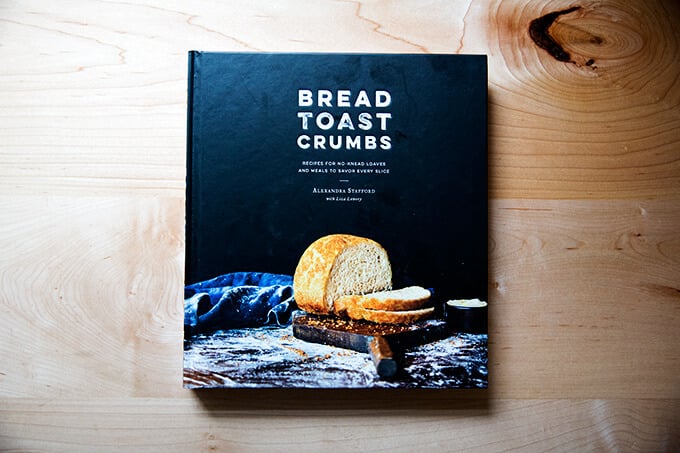













6,393 Comments on “My Mother’s Peasant Bread: The Best Easiest Bread You Will Ever Make”
I’m doomed. Made per your instructions. 1/4 KA whole wheat 3/4 AP. Cinnamon and white raisins in dough. 3,500 ft. elev. Rises looked normal. Tastes wonderful, BUT rose only barely above rim of 1 qt. bowl during baking. A but crunchy on top. Oven temp. seems pretty correct. Not your fault.
Hi Bob! Thanks for writing and sharing your notes. One thing you could try is mixing your dough, then immediately sticking it in the fridge for 24 hours or longer in a lidded vessel (be sure it’s large enough to allow the dough to grow). Then, when you are ready to bake, proceed with the recipe, giving ample time for the dough to rise since it will be cold. The method I am describing is based on this focaccia, which my friends who live at high elevation have great success with.
I found this recipe on Christmas Eve and made some immediately! It was so delicious, I’ve made it three times since then, and it’s only been a month. Before the second rise, after moving to the baking dishes, I brush the top with melted butter and sprinkle with sea salt. 🤤 I never want to share. 😬 I have some rising right now!!!
So nice to read all of this, Teresa! Thanks for writing and sharing your notes 🙂
Just like all your recipes this one is such a keeper! My husband can’t get enough of it but it is making me neglect my sourdough starter 🙂 any way to incorporate sourdough or sourdough discard into this simple recipe! Thanks again for all your recipes that help make cooking fun!
Hi and yes! Are you using a scale to measure? If so, use 100 grams of starter in place of 50 grams of the flour and 50 grams of the water. The dough, of course, will take longer to rise, but the overall process is the same.
I do have a scale! Do you mean active sourdough starter and don’t use yeast? Or just use sourdough discard
Great! You can do either! If you use discard, use a little bit of yeast: 1/2 or 1 teaspoon. If you use active starter you can omit the yeast, but again, budge more time for the bulk fermentation and the final proof.
Sorry just thought of another question. This is a no knead bread but if i use sourdough should i knead in mixer or do a series of stretch and folds?
I would do stretches and folds 🙂
Hi Lisa and Ali! I, too, have been hoping for a sourdough version of your mom’s peasant bread which I have been baking and loving for two years! I like the idea of a sourdough loaf baked in my 1-qt bowls, and a crust that isn’t quite as “crusty” as the Dutch oven loaves. Lisa – did you have success adjusting the recipe per Ali’s recommendations? Ali, I tried subbing out 50 g flour and 50 g water for 100 g of active sourdough starter (100% hydration), but the dough was very, very wet. I know sourdough has a very high hydration, but I mean… this was REALLY wet. I tried adding a little more flour, and I tried strengthening the dough with a few stretch-and-folds, but it didn’t work, even after giving it 6 hours of rising time. I’m not discouraged… I want to learn how to do this! Do you have a recipe somewhere for sourdough peasant loaves? What might I be doing wrong? Thank you so much for your generosity, and for helping us learn the joys of bread baking!
Hi Lynette! I don’t have a recipe anywhere. Here are some thoughts: Use bread flour. And maybe try using 100 grams of starter, but only subtract 50 grams of water (as opposed to 50 grams each flour and water).
You can see pictures of the sourdough peasant bread on this sourdough focaccia (at the end of the post), and that is using the sourdough focaccia recipe, but I do think lowering the hydration of this bread would be beneficial.
Hi Lynette and Ali,
I have not tried the sourdough version yet Hope to get to it soon and will try with more flour. i already find the dough pretty wet to work with but Aliks videos sure help.
By the way, I did the spinach dip in peasant bread for Super Bowl and it was a hit!
Oh yay! Great to hear about the spinach-artichoke dip in the bread bowl — bread bowls never get old!
I love your videos. No music and the natural sounds while preparing the bread. Just wonderful!
Thank you, Vee 🙂 🙂 🙂
Fantastic recipe! It was so easy to prepare and it baked up beautifully and delicious! Thank you for sharing.
Great to hear, Brandi! Thanks so much for writing 🙂 🙂 🙂
LOVEEEEE! Thank you so much for sharing this recipe <3
Great to hear, Lysette 🙂 🙂 🙂
Love this recipe! Have you ever doubled the recipe? Does it work?
Yep! Double away 🙂
I love this bread! It reminds me of a homemade bread my mother used to buy from the Amish back in Pennsylvania when I was a child. It is so easy, I think I make it too often! Because it is just me, I halve the recipe, otherwise, I would eat both loaves myself. I’m getting ready to make another batch! I’m thinking a grilled cheese and ham sandwich might be good, hmmm?🤔 Thank you for sharing this recipe, it is definitely a keeper!
It makes the best grilled cheese!! Great to read all of this, Kim 🙂 Thanks for writing.
This is now my go-to bread recipe. My Dutch oven may get lonely! I’ve made it 8+ times in the past couple weeks.
Tonight, I added 1/4 cup of cocoa powder and a handful of chocolate morsels, and OMG. So good.
Can’t to keep experimenting!
Thank you Alexandra (and mom!)
Great to hear, Courtney!! Thanks so much for writing and sharing all of these notes 🙂 🙂 🙂
I discovered this recipe just before thanksgiving. I double the recipe, then equally divide the dough into 5″ ramekins. I made it for Thanksgiving dinner, and have made it no less than 5 times in the past 3 months…This is a fantastic bread…
Great to hear, Gerald! Thanks so much for writing 🙂 🙂 🙂
Thank you for a great recipe. I tried the loaf pans today and I proofed it like normal with a good rise but it deflated in the oven. What did I do wrong?
Hi Jim! It sounds as though it overproofed a bit in the loaf pan. How long roughly was the proof in the pan?
It was about 45 minutes to an hour.
OK, hmmm… that’s about right.
Are you using a scale to measure? What type of flour are you using?
I used King Author’s flour. The yeast was fresh and active. The first rise doubled in size. The second rise rose just above the loaf pan. What are some of the reasons bread would deflate. Thank you
It’s possible you didn’t bake it long enough.
My suggestions would be to use a scale to measure all of the ingredients to ensure you are measuring accurately, and perhaps to try KAF bread flour if you are not already. Err on the side of overbaking — it’s a high hydration dough and very forgiving, so bake it longer if you are in question of it being done or not.
The most fool-proof bread I’ve ever met. I make this every other day now, it’s such a staple in our home. This recipe has made me a more confident bread baker – I’ll be trying the focaccia recipe this week.
Thank you, Ali, sincerely.
(I accidentally posted this on the focaccia recipe. I’m sure it’s true for that recipe, too, but it was intended for this one. Oops!)
So nice to read all of this, Laurie 🙂 🙂 🙂 And no worries about posting on the wrong recipe… it’s all nice to read regardless of where it lands 🙂
Such an easy and delicious recipe! I was wondering if I could add cheese and some seasoning to the dough to make a cheese bread, would that work with the same measurements or should I tweak it a little?
Yes! I have a few variations of cheese breads in my book, Bread Toast Crumbs. No need to make adjustments to the other measurements.
I made this today and it’s fabulous. However, I have a question regarding your flour measurement. I weigh all my ingredients and my King Arthur flour is 120 grams per cup / 480 grams for 4 cups. Your recipe shows using 4 cups @ 512 grams. My dough was very wet and loose, but the end result was great. Yet I wonder if I should be using the 512 grams instead and if it makes a difference. Thanks.
I think you will kind 512 grams will make for a much less sticky dough… though the dough definitely should be wet and sticky 🙂
My standar is 1 cup = 128 grams … everyone uses a different standard, which makes things tricky. I just always use the gram measurements of whatever recipe I am following.
Love this recipe… comes out perfect everytime!!
Great to hear, Shannan!
Hi Ali, It’s Ali!
Going to make this peasant bread but have two questions so it will turn out perfectly.
I always bulk ferment overnight, so is there any adjustment to the process? Do I let it come to room temperature before punching down and placing it in the greased bowl? Do I let the rise time longer in the bowl?
Also, I am using the two quart bowl as I only have one pyrex. How high up the bowl will the dough rise and is there any adjustment in baking time. Thanks so much for all this yummy goodness!
Hi! When you say you “bulk ferment overnight” are you doing this in the fridge?
Sorry I wasn’t clear. Yes, I always put dough in the fridge overnight because my family adores the deeper development of yeasty flavor.
Any thoughts on doing the first rise in the fridge overnight would be great. Should I leave it out for some time to come to closer to room temperature? By the way, I did make it the regular way and brought some to my Mom and she begged for more. Using it for my husband’s sandwiches he takes to work and he loves it too. Thank YOU and your MOM too!
Great to hear!
Yes, absolutely: mix the dough, stick it in the fridge immediately (in a lidded vessel), and keep it there for as long as 3 days — make sure the vessel is large enough bc the dough will grow considerably. And yes, the second rise will take much longer due to the dough being cold, so just be patient.
Alexandra I give thanks to you and your mother for simply the best bread recipe ever. I have made it loads of times and it works every single time. I’m now trying to spread the word! Now experimenting baking it in a Dutch oven and it worked like a treat. Thank you thank you thank you for being so generous and sharing it.
Awww Penny 🙂 🙂 🙂 So nice to read all of this. Thanks so much for writing.
I love this recipe, I’ve made it twice now. But the problem I’m having is with the second rise. It doesn’t seem to rise enough in the 30 minutes I give it. It is February and my house is cold, but it sits on the stove on the warm parts of it that I can find. When I bake it it doesn’t rise any more than when I put it in the oven. Any tips?
Hi Linda! What size bowls are you using?
I’m not sure, it’s not written on the bottom of the bowls, but I think around 1 quart, they hold a little more than 4 cups of water. Maybe I should go smaller?
No, that’s the right size — 1 quart or 1 liter bowls are perfect.
I would try either letting the second rise go longer… just be patient and wait until the dough crowns the rim. It may take closer to an hour or longer.
Bread flour will also give you a better rise.
Are you using a scale to measure? What typ of yeast?
not using a scale, but will next time. I’m using he instant years. And I’m using AP flour at the moment, but I can get bread flour. Thanks!
Got it! Good luck on your next trial!
Love this! Just made my second batch. I made one with the everything bagel and tried to other with cinnamon and sugar. The cinnamon and sugar one is awesome!
Great to hear, Jenni! Thanks so much for writing 🙂 🙂 🙂
Fantastic recipe! I have made it several times using sourdough starter. Works like a dream.
Great to hear, Stephanie!
This bread was so easy just as described! Love that it can be made just a few hours before dinner for fresh warm baked bread! Not to mention it was delicious & so fluffy.
Great to hear, Teresa! Thanks so much for writing 🙂 🙂 🙂
My teenage son said “You can just plan on me eating this entire thing today” so I’d say it was a hit! I weighed out the measurements with my food scale (which is good because it took more than one standard package of yeast to weigh correctly) and baked mine with the Dutch oven method. It was perfectly crispy on the outside and soft on the inside. Will definitely make again!
Awwww I love this 🙂 Great to hear! Thanks for writing and sharing your notes.
I made this as suggested for two loaves in loaf pans. It is so good, hardly any work, and can’t thank you enough. It was delicious and we sliced some up for sandwiches with no trouble at all. Thankful for you and for your mom!
Great to hear, Lore! Thanks for writing 🙂
I have made this recipe multiple times in my Dutch oven and it bakes up perfectly. I just made your homemade ricotta cheese and states you can use the whey to make bread ( it links to this recipe). Do I replace the water with the reserved whey?
Ty
Yes! Keep in mind: if you’ve refrigerated the whey, your dough will be colder upon mixing, so it may take longer to rise — just be patient. You may also want to reduce the salt slightly because the whey itself will be slightly salty. Also: the bread will brown faster in the oven, so keep an eye on it. I might consider baking it at 400ºF to start.
I tried this recipe and it is the best version of Peasant bread I have ever made. Thank you Alexandra!!!
Great to hear, Keisha! Thanks for writing 🙂
My mom would make this bread (in the sixties). We called it TV bread because she would put it on top the (old school) TV to rise. Thanks for sparking that memory!
Oh I love this 🙂 🙂 🙂 Thanks for sharing.
2 1 quart bowls
https://www.amazon.com/dp/B08LZ6FKNH?ref=ppx_yo2ov_dt_b_product_details&th=1
Thank you!
I’ve made the peasant bread 2 times and it came out good. I made the gluten bread once, I didn’t like it, which had nothing to do with the recipe. I bought the cookbook and I love it. I read it like a book.
Aww thanks, Annette 🙂 🙂 :). Bummer about the gluten-free bread. Which gluten-free flour did you use? Not sure if you used the gf recipe in the book, but the updated one is on the blog: Gluten-Free Peasant Bread Recipe
What size of loaf pan is everyone using when they don’t use the 1 quart bowls?
I just reread the recipe and the answer was right there🙄
Glad you found your answer, Anna! Good luck 🙂
Hello! Did I miss where the peasant bread recipe said what temperature to bake it at? I saw a temp for a Dutch oven, it not for a regular oven. Thanks! I’m excited to try it!
Hi! It’s in the recipe box: 425ºF for 15 minutes; 375ºF for 17-20 minutes more.
This is an easy to follow fool proof bread recipe, Thank you! I’d just lower the amount of salt as it is a tad salty, otherwise we love it!